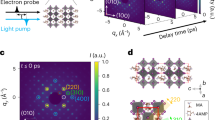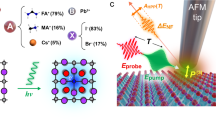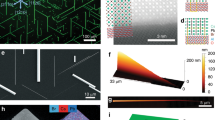Abstract
Excitation localization involving dynamic nanoscale distortions is a central aspect of photocatalysis1, quantum materials2 and molecular optoelectronics3. Experimental characterization of such distortions requires techniques sensitive to the formation of point-defect-like local structural rearrangements in real time. Here, we visualize excitation-induced strain fields in a prototypical member of the lead halide perovskites4 via femtosecond resolution diffuse X-ray scattering measurements. This enables momentum-resolved phonon spectroscopy of the locally distorted structure and reveals radially expanding nanometre-scale strain fields associated with the formation and relaxation of polarons in photoexcited perovskites. Quantitative estimates of the magnitude and shape of this polaronic distortion are obtained, providing direct insights into the dynamic structural distortions that occur in these materials5,6,7,8,9. Optical pump–probe reflection spectroscopy corroborates these results and shows how these large polaronic distortions transiently modify the carrier effective mass, providing a unified picture of the coupled structural and electronic dynamics that underlie the optoelectronic functionality of the hybrid perovskites.
This is a preview of subscription content, access via your institution
Access options
Access Nature and 54 other Nature Portfolio journals
Get Nature+, our best-value online-access subscription
$29.99 / 30 days
cancel any time
Subscribe to this journal
Receive 12 print issues and online access
$259.00 per year
only $21.58 per issue
Buy this article
- Purchase on Springer Link
- Instant access to full article PDF
Prices may be subject to local taxes which are calculated during checkout




Similar content being viewed by others
Data availability
The data represented in Figs. 1, 2, 3 and 4 are provided with the paper as source data. Other datasets generated and/or analysed during the current study are available from A.M.L. upon reasonable request. Source data are provided with this paper.
References
Carneiro, L. M. et al. Excitation-wavelength-dependent small polaron trapping of photoexcited carriers in α-Fe2O3. Nat. Mater. 16, 819–825 (2017).
Koepsell, J. et al. Imaging magnetic polarons in the doped Fermi–Hubbard model. Nature 572, 358–362 (2019).
Fratini, S., Ciuchi, S., Mayou, D., Trambly de Laissardière, G. & Troisi, A. A map of high-mobility molecular semiconductors. Nat. Mater. 16, 998–1002 (2017).
Brenner, T. M., Egger, D. A., Kronik, L., Hodes, G. & Cahen, D. Hybrid organic–inorganic perovskites: low-cost semiconductors with intriguing charge-transport properties. Nat. Rev. Mater. 1, 15007 (2016).
Zheng, F. & Wang, L.-w Large polaron formation and its effect on electron transport in hybrid perovskites. Energy Environ. Sci. 12, 1219–1230 (2019).
Miyata, K. et al. Large polarons in lead halide perovskites. Sci. Adv. 3, e1701217 (2017).
Ghosh, D., Welch, E., Neukirch, A. J., Zakhidov, A. & Tretiak, S. Polarons in halide perovskites: a perspective. J. Phys. Chem. Lett. 11, 3271–3286 (2020).
Lan, Y. et al. Ultrafast correlated charge and lattice motion in a hybrid metal halide perovskite. Sci. Adv. 5, eaaw5558 (2019).
Guzelturk, B. et al. Terahertz emission from hybrid perovskites driven by ultrafast charge separation and strong electron–phonon coupling. Adv. Mater. 30, 1704737 (2018).
Stranks, S. D. & Plochocka, P. The influence of the Rashba effect. Nat. Mater. 17, 381–382 (2018).
Frost, J. M. et al. Atomistic origins of high-performance in hybrid halide perovskite solar cells. Nano Lett. 14, 2584–2590 (2014).
Wu, X. et al. Light-induced picosecond rotational disordering of the inorganic sublattice in hybrid perovskites. Sci. Adv. 3, e1602388 (2017).
Cinquanta, E. et al. Ultrafast THz probe of photoinduced polarons in lead-halide perovskites. Phys. Rev. Lett. 122, 166601 (2019).
Thouin, F. et al. Phonon coherences reveal the polaronic character of excitons in two-dimensional lead halide perovskites. Nat. Mater. 18, 349–356 (2019).
Miyata, K. & Zhu, X.-Y. Ferroelectric large polarons. Nat. Mater. 17, 379–381 (2018).
Guo, Y. et al. Dynamic emission Stokes shift and liquid-like dielectric solvation of band edge carriers in lead-halide perovskites. Nat. Commun. 10, 1175 (2019).
Anusca, I. et al. Dielectric response: answer to many questions in the methylammonium lead halide solar cell absorbers. Adv. Energy Mater. 7, 1700600 (2017).
Chollet, M. et al. The X-ray pump–probe instrument at the Linac Coherent Light Source. J. Synchrotron Rad. 22, 503–507 (2015).
Peisl, H. Defect properties from X-ray scattering experiments. J. Phys. Colloq. 37, C7–C47 (1976).
Lindenberg, A. M. et al. Time-resolved X-ray diffraction from coherent phonons during a laser-induced phase transition. Phys. Rev. Lett. 84, 111–114 (2000).
Larsson, J. et al. Picosecond X-ray diffraction studies of laser-excited acoustic phonons in InSb. Appl. Phys. A 75, 467–478 (2002).
Fultz, B. & Howe, J. M. Transmission Electron Microscopy and Diffractometry of Materials (Springer-Verlag, 2013).
Sendner, M. et al. Optical phonons in methylammonium lead halide perovskites and implications for charge transport. Mater. Horiz. 3, 613–620 (2016).
Jani, H. & Duan, L. Time-frequency spectroscopy of GaAs transient dispersion using few-cycle pump-probe reflectometry. Phys. Rev. Appl. 13, 054010 (2020).
Shcherbakov, M. R. et al. Ultrafast all-optical tuning of direct-gap semiconductor metasurfaces. Nat. Commun. 8, 17 (2017).
Bennett, B. R., Soref, R. A. & Del Alamo, J. A. Carrier-induced change in refractive index of InP, GaAs and InGaAsP. IEEE J. Quantum Electron. 26, 113–122 (1990).
Walsh, A., Da Silva, J. L. F. & Wei, S.-H. Origins of band-gap renormalization in degenerately doped semiconductors. Phys. Rev. B 78, 075211 (2008).
Berggren, K. F. & Sernelius, B. E. Band-gap narrowing in heavily doped many-valley semiconductors. Phys. Rev. B 24, 1971–1986 (1981).
Smart, T. J., Pham, T. A., Ping, Y. & Ogitsu, T. Optical absorption induced by small polaron formation in transition metal oxides: the case of Co3O4. Phys. Rev. Mater. 3, 102401 (2019).
van Mechelen, J. L. M. et al. Electron-phonon interaction and charge carrier mass enhancement in SrTiO3. Phys. Rev. Lett. 100, 226403 (2008).
Acknowledgements
This work is supported by the US Department of Energy (DOE), Office of Basic Energy Sciences, Division of Materials Sciences and Engineering, under contract no. DE-AC02-76SF00515 (B.G., M.T., S.T., G.A.D.L.P., H.I.K. and A.M.L.). Use of the Linac Coherent Light Source (LCLS), SLAC National Accelerator Laboratory, is supported by the US Department of Energy, Office of Science, Office of Basic Energy Sciences under contract no. DE-AC02-76SF00515. M.D.S. is supported by a graduate fellowship from the Center for Molecular Analysis and Design (CMAD) at Stanford University. T.W. and F.D. acknowledge funding from an EPSRC NI grant (EP/R044481/1). S.F. acknowledges funding from the EPSRC and the Studienstiftung des deutschen Volkes. T.J.W.V.D.G. acknowledges support from the EPSRC Cambridge NanoDTC, EP/L015978/1 and the Schiff Foundation. S.A.B. acknowledges support from the EPSRC Centre for Doctoral Training in Graphene Technology (EP/L016087/1). F.D. acknowledges support from the DFG Emmy Noether Programme (project no. 387651688) and the Winton Programme for the Physics of Sustainability. T.W. received funding from the European Union’s Horizon 2020 research and innovation programme under Marie Skłodowska-Curie grant agreement no. 838772. M.F.T. and H.-G.S. acknowledge support from the Center for Hybrid Organic Inorganic Semiconductors for Energy (CHOISE), an Energy Frontier Research Center funded by the Office of Basic Energy Sciences, Office of Science within the US Department of Energy through contract no. DE-AC36-08G028308 for assistance with the LCLS experiments and interpretation. We thank Y. Rakita for support with single crystal growth.
Author information
Authors and Affiliations
Contributions
A.M.L., B.G. and M.D.S. conceived the experiment; B.G. led the LCLS experimental team consisting of B.G., T.J.W.V.D.G., M.D.S., M.T., S.T., H.-G.S., G.A.D.L.P., R.A.-M., T.S. and A.M.L. Data analysis of the time-resolved X-ray scattering measurements was performed by B.G. with contributions from T.J.W.V.D.G., M.T. and S.T. The data were interpreted by B.G. and A.M.L. with contributions from T.J.W.V.D.G., H.-G.S., M.T., S.T., M.F.T. and F.D. Perovskite single crystal samples were synthesized by M.D.S. who also performed their static characterizations. A.M.L. performed the polaron model calculations. T.W., S.A.B., S.F. and F.D. performed the transient reflectivity measurements. S.F. performed the transient grating photoluminescence measurements and static optical characterization. T.W. and F.D. analysed and interpreted the transient reflectivity data. A.M.L., F.D., M.F.T., H.I.K. and D.Z. supervised the research. B.G., A.M.L., T.W. and F.D. wrote the paper with contributions from all authors.
Corresponding author
Ethics declarations
Competing interests
The authors declare no competing interests.
Additional information
Peer review information Nature Materials thanks Paul Beaud, Elbert Chia and Sergei Tretiak for their contribution to the peer review of this work.
Publisher’s note Springer Nature remains neutral with regard to jurisdictional claims in published maps and institutional affiliations.
Supplementary information
Supplementary Information
Supplementary Figs. 1–17, Sections 1–11 and refs. 1–29.
Source data
Source Data Fig. 1
Source data for Fig. 1 with each panel given as different tab.
Source Data Fig. 2
Source data for Figure 2 with each panel given as different tab.
Source Data Fig. 3
Source data for Figure 3 with each panel given as different tab.
Source Data Fig. 4
Source data for Figure 4 with each panel given as different tab.
Rights and permissions
About this article
Cite this article
Guzelturk, B., Winkler, T., Van de Goor, T.W.J. et al. Visualization of dynamic polaronic strain fields in hybrid lead halide perovskites. Nat. Mater. 20, 618–623 (2021). https://doi.org/10.1038/s41563-020-00865-5
Received:
Accepted:
Published:
Issue Date:
DOI: https://doi.org/10.1038/s41563-020-00865-5
This article is cited by
-
Spin-orbital Jahn-Teller bipolarons
Nature Communications (2024)
-
Coupling to octahedral tilts in halide perovskite nanocrystals induces phonon-mediated attractive interactions between excitons
Nature Physics (2024)
-
Exciton dissociation in 2D layered metal-halide perovskites
Nature Communications (2023)
-
Polarons in two-dimensional atomic crystals
Nature Physics (2023)
-
Photocarrier-induced persistent structural polarization in soft-lattice lead halide perovskites
Nature Nanotechnology (2023)



